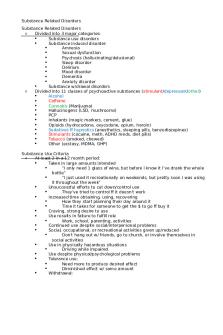Equity looks at substance rather than form PDF

| Title | Equity looks at substance rather than form |
|---|---|
| Course | Bachelor of Laws |
| Institution | Makerere University |
| Pages | 2 |
| File Size | 46.9 KB |
| File Type | |
| Total Downloads | 98 |
| Total Views | 130 |
Summary
Notes on the equity and trusts course unit on the subtopic equity looks at substance rather than form....
Description
Equity looks at substance rather than form Equity is the body of rules developed and applied by the court of Chancery. An online version the free dictionary defines a maxim as; A maxim is a broad statement of principle, the truth and reasonableness of which are self-evident. Maxims were originally quoted in Latin and were not written down in an organized code or enacted by legislature but they have been handed down through generations of judges and the wording of a maxim may vary from case to case. This maxim means that a party who sues in equity can recover the precise thing that he or she seeks rather than monetary damages as a substitute for it. This maxim is the remedy of specific perfomance Philip H Pettit in his book Equity and the law of trusts explains that Equity looks at substance rather than form as it may hold that a trust has been created even though the word trust has not been used. IMPORTANCE OF THE MAXIM Under this maxim throughout the whole of the substantive law, equity deals with a matter according to its actual substance and regards mere form as a secondary consideration. These maxims represent the accumulated insight and wisdom of the early courts of equity and are often used as a guide in the application of equitable principles. According to the book titled Principles of Equity and Trusts second Edition by Samantha Hepburn it states that this maxim reflects one of the basic principles of equity. When considering the circumstances and law applicable to a particular case, equity will not regard itself as being bound by formality if equity finds that by insisting upon a particular form, the substance of the issue is over whelmed, it will hold such insistence to be inequitable. For example in a situation where a trust was intended but has not been expressly created through compliance with the formal requirements, if sufficient evidence of an intention to create a trust can be proven, equity will enforce the intention of the parties despite the absence of any express wording. Application This was demonstrated in the case of Parvin V Thorold through the words of Lord Romily who remarked that an agreement between a vendor and purchaser did not rest upon the limitations of time and that when charges against the vendor for specific performance altered the essence of the contract, it was equity that referred the parties to the form of the arrangement. Time was originally not of essence of the contract although express notice will make time of the essence of the contract, where a reasonable time is specified the notice of the 21st October did not specify a reasonable time for this purpose. And this maxim has also been applied in Ugandan cases for example in Olanya v Achullu(civil Appeal 2016/38)[2018],The court explained that there is a long standing maxim of equity that,"equity looks at
substance rather than form ".In the same vein,if the agreement is described as memorandum of understanding but in substance and from all indications is an enforceable contract the courts will enforce the apparent memorandum of understanding as a contract with its attendant legal consequences. 1995 constitution of the Republic of Uganda, Article 126(2)(e) Substantive Justice shall be administered without undue regard to technicalities....
Similar Free PDFs

Substance Abuse.Concept Map
- 1 Pages

Substance Related Disorders
- 9 Pages

1.2. Amount of Substance
- 4 Pages

Chapter 17 Substance Abuse
- 1 Pages

Maxims of Equity Equity Law
- 5 Pages

CH 6 Substance USE Assessment
- 6 Pages
Popular Institutions
- Tinajero National High School - Annex
- Politeknik Caltex Riau
- Yokohama City University
- SGT University
- University of Al-Qadisiyah
- Divine Word College of Vigan
- Techniek College Rotterdam
- Universidade de Santiago
- Universiti Teknologi MARA Cawangan Johor Kampus Pasir Gudang
- Poltekkes Kemenkes Yogyakarta
- Baguio City National High School
- Colegio san marcos
- preparatoria uno
- Centro de Bachillerato Tecnológico Industrial y de Servicios No. 107
- Dalian Maritime University
- Quang Trung Secondary School
- Colegio Tecnológico en Informática
- Corporación Regional de Educación Superior
- Grupo CEDVA
- Dar Al Uloom University
- Centro de Estudios Preuniversitarios de la Universidad Nacional de Ingeniería
- 上智大学
- Aakash International School, Nuna Majara
- San Felipe Neri Catholic School
- Kang Chiao International School - New Taipei City
- Misamis Occidental National High School
- Institución Educativa Escuela Normal Juan Ladrilleros
- Kolehiyo ng Pantukan
- Batanes State College
- Instituto Continental
- Sekolah Menengah Kejuruan Kesehatan Kaltara (Tarakan)
- Colegio de La Inmaculada Concepcion - Cebu









